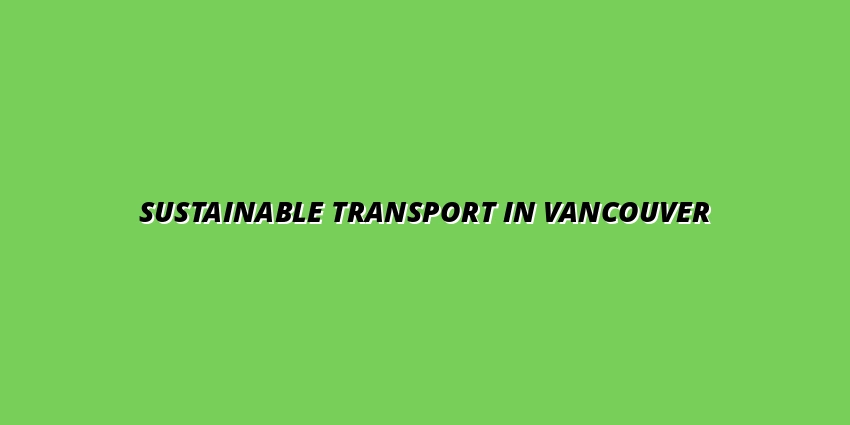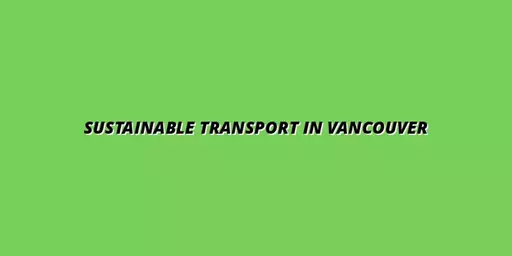Sustainable Transport in Vancouver
By Emilia Cartwright / Nov 24
Curious about how one city can lead the charge in sustainable living? Vancouver is paving the way with innovative ideas that not only enhance urban mobility but also protect our planet. Let's explore the key insights that can inspire you to embrace sustainable transportation in your daily life!
Vancouver is committed to a greener future through strategic initiatives focusing on sustainable urban mobility. Here's how the city is making a difference.
Vancouver aims to reduce emissions by 50% by 2030. Key initiatives include:
Ambitious targets for a greener city.
Walking and biking are crucial for reducing emissions and offer:
A win-win for people and the planet.
Optimizing existing resources to minimize environmental impact:
Smart strategies for sustainable growth.
Ensuring equal access to sustainable options for all residents:
An inclusive approach for a healthier future.
In the bustling heart of Vancouver, sustainable urban transportation is more than just a trend; it’s a way of life! This city is taking significant strides to ensure that getting around is not only efficient but also eco-friendly. So, what exactly does sustainable transportation mean? Let’s dive into this topic to explore how Vancouver is leading the charge!
Sustainable transportation refers to mobility options that are efficient, reduce environmental impact, and promote social equity. This can encompass various modes, including public transit, biking, walking, and shared vehicles. The aim is to create systems that minimize pollution and greenhouse gas emissions while offering affordable options for everyone.
In Vancouver, the commitment to sustainable transport is evident through the integration of green technologies and infrastructure. For instance, initiatives like bike lanes and electric buses are becoming commonplace, making it easier for residents to choose eco-conscious options. For more insights into how the city is adapting, check out our article on Sustainable Transportation Innovations Unveiled.
Vancouver stands out as a leader in sustainable transportation for several reasons:
The city’s ethos is deeply rooted in the belief that urban living can coexist with environmental responsibility. As a Vancouverite, I see this daily—whether it’s friends opting for public transit or community members advocating for more bike paths. The energy is contagious!
Urban mobility significantly impacts our environment, affecting air quality, energy consumption, and public health. By prioritizing sustainable options, we can reduce our carbon footprints and promote a healthier lifestyle. In fact, studies show that cities that invest in sustainable transportation enjoy cleaner air and improved community well-being.
As we shift towards more eco-friendly practices, it's crucial to recognize how each of us contributes to this movement. Small choices, like opting for a bike instead of a car or using public transit, can lead to meaningful change. Let's embrace these habits to keep our beautiful city thriving!
What sustainable transportation options do you currently use in Vancouver? Share your thoughts below and let’s inspire each other to make greener choices!
Vancouver is taking significant steps towards reducing its carbon footprint through sustainable transportation. The city's Climate Emergency Action Plan lays out specific initiatives aimed at tackling climate change by redesigning how we move around our urban space. This plan includes promoting public transit, enhancing biking infrastructure, and encouraging the use of eco-friendly vehicles. It’s a comprehensive approach that aligns perfectly with our mission at A Piece of Van City to empower residents to live well while being mindful of the planet!
Some key initiatives from the Climate Emergency Action Plan include:
These initiatives not only aim to curb greenhouse gas emissions but also promote a healthier lifestyle for all Vancouverites. I love how the city is not just talking about change; it's actively making it happen.
As part of the Climate Emergency Action Plan, Vancouver has set ambitious targets to reduce emissions by 50% by 2030. This commitment reflects a strong community desire for a cleaner, greener city. The focus on sustainable transport is especially exciting because it opens up numerous opportunities for people to make eco-conscious decisions in their daily lives. Trust me; every little bit helps!
Key initiatives under this plan include:
Through these efforts, Vancouver is setting a precedent for other cities to follow. It’s refreshing to see a city embrace change with such enthusiasm!
Active transportation, such as walking and biking, plays a vital role in reducing emissions. In Vancouver, more people are choosing to travel this way, and it's making a noticeable difference! Not only does this shift help decrease air pollution, but it also promotes health and wellness among residents. It’s a win-win!
Consider these benefits of active transportation:
At A Piece of Van City, I always encourage everyone to explore their neighborhoods on foot or by bike. There's so much more to discover when you're not zooming by in a car! For those looking to make the most of public transit, our guide on Navigating Vancouver Transit: Tips & Hacks offers valuable advice.
Transportation Demand Management (TDM) is another key strategy in Vancouver’s quest for a sustainable future. TDM focuses on optimizing the use of existing transportation resources rather than simply expanding infrastructure. This is crucial for managing growth while minimizing environmental impacts.
Some effective TDM strategies include:
By integrating these strategies, Vancouver aims to create a more sustainable urban environment that benefits us all. It's exciting to witness how these collective efforts can lead to significant change!
Engaging the community is essential for the success of sustainable transport solutions. At A Piece of Van City, we believe that everyone—especially newcomers and diverse communities—should have the resources and support they need to participate actively in sustainable practices. The more we collaborate, the more impact we can make!
Vancouver is a melting pot of cultures, and ensuring everyone can access sustainable transport options is crucial. There are various resources available to help newcomers navigate the public transit system and get involved in local initiatives.
By leveraging these resources, newcomers can feel more confident in exploring their new city sustainably and engaging with their communities.
One of the most inspiring aspects of Vancouver is the numerous success stories of residents who have embraced sustainable commuting. From families choosing to bike together to individuals utilizing public transit instead of personal vehicles, these narratives highlight the positive impact of making eco-conscious choices.
Some success stories include:
These examples not only motivate others to follow suit but also foster a sense of community and shared responsibility for our environment!
Transportation equity is an essential consideration in urban planning. It ensures that all residents have equal access to sustainable transportation options, regardless of their socio-economic status. In Vancouver, efforts are being made to address these disparities and ensure that everyone can benefit from sustainable transport developments.
Some key initiatives include:
By prioritizing equity, we can create a more inclusive city where sustainable transportation is accessible to all. It's a critical step towards a healthier future for everyone!
Here are some frequently asked questions about sustainable transportation in Vancouver:
Feeling inspired? It’s time to take action towards a greener commute! Whether you’re a longtime Vancouverite or a newcomer, there are plenty of ways to get involved and make a difference. Together, we can shape a sustainable future for our city!
Joining local initiatives is a fantastic way to engage with your community and promote sustainable transport solutions. Vancouver offers numerous programs and events where you can connect with like-minded individuals and contribute to collective efforts.
Every action counts, and your involvement can lead to meaningful change in our community! For more information on city-wide initiatives, consider exploring resources about Vancouver's Grassroots Green Initiatives.
Community bike events are a great way to foster engagement and participation in sustainable transportation. These events not only promote cycling but also build connections among residents.
Look out for:
These gatherings are fun opportunities to meet fellow biking enthusiasts while promoting a greener way to travel around the city!
As we look to the future, Vancouver's commitment to sustainable transportation is promising. The community's engagement, along with the city's innovative initiatives, creates a perfect storm for positive change. Let’s continue to support and promote sustainable transport options, ensuring that our beautiful city remains vibrant and livable for generations to come. I invite you to join me on this journey—together, we can make a difference!
Here is a quick recap of the important points discussed in the article:



 Sustainable Transport in Vancouver
Curious about how one city can lead the charge in sustainable living? Vancouver is paving the way wi
Sustainable Transport in Vancouver
Curious about how one city can lead the charge in sustainable living? Vancouver is paving the way wi
 Vancouver's Affordable Housing Resources
Struggling to find an affordable home in Vancouver? You're not alone. With numerous programs and res
Vancouver's Affordable Housing Resources
Struggling to find an affordable home in Vancouver? You're not alone. With numerous programs and res
 Vancouver Grocery Tips for Newcomers
Have you ever wondered how to navigate grocery shopping in one of Canada's most expensive cities wit
Vancouver Grocery Tips for Newcomers
Have you ever wondered how to navigate grocery shopping in one of Canada's most expensive cities wit